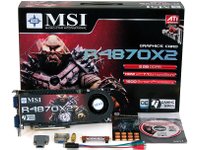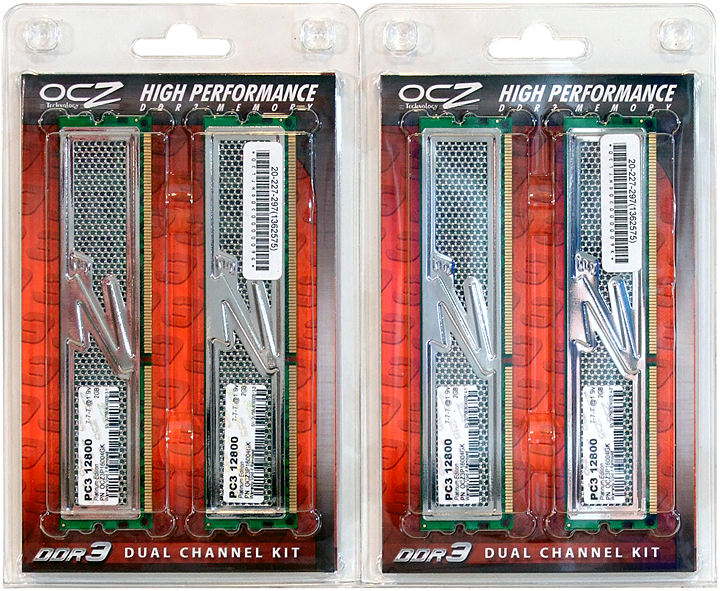System Builder Marathon: The $4,500 Super PC
Graphics And RAM
MSI R4870X2-T2D2G-OC
The top choices for gaming power are multi-GPU solutions from Nvidia and AMD. You either have three-way SLI configured GTX 280 graphics cards or CrossFireX solutions with two dual-processor Radeon HD 4870 X2 cards. We looked at many benchmarks before deciding that a pair of HD 4870 X2s would be the better choice for our particular games, and would like to suggest that other buyers consider their favorite titles before making a purchasing decision.


Read Customer Reviews of MSI’s HD 4870 X2 (R4870X2-T2D2G-OC )
Many manufacturers offer AMD’s top Radeon HD 4870 X2 solution, but only a few provide overclocked versions. We don’t like paying for someone else to do our overclocking, but when we ordered the MSI R4870X2-T2D2G-OC it was priced similarly to other models running at stock speeds. Sure, we’ll take the extra frequency.
Since we ordered MSI’s overclocked cards, instant discounts on this model have vanished at the same time as prices have decreased on some non-overclocked brands. With a difference of $60 for a pair of cards, we still have little to regret. MSI overclocks its graphics processor to 780 MHz, compared to the stock speed of 750 MHz, and we haven’t found any other changes. A higher base speed means we can rest assured that the cards will clock up to at least to the speed that MSI has set.
OCZ Technology OCZ3P16004GK
Read Customer Reviews of OCZ’s PC3-12800 Platinum Edition OCZ3P16004GK (8.0 GB)
With 4 GB of RAM quickly becoming the standard Vista configuration, we wanted to take our system a step forward with 8 GB. This certainly should have been easy, given DDR3’s support for up to 16 GB per module, yet manufacturers have yet to make DDR3 modules above 2 GB widely available. We were stuck buying four modules, in the form of two sets from OCZ.
OCZ’s PC3-12800 Platinum Edition wasn’t necessarily our first choice here. Kingston HyperX had received top honors for its tight timings at high clock speeds in our Mainstream DDR3-1600 Shootout and was even listed at a lower price from NewEgg. Unfortunately, by the time our order was processed the parts we wanted were out of stock.
The truly unfortunate problem was that, based on factory-overclocked slower-speed parts, the modules we received ran hot. In fact, running four of them at rated voltage resulted in unstable temperatures at any reasonable speed. We knew in advance that performance memory would run warm, but certainly not this warm— especially when we considered that our case has a 220 mm intake fan blowing in this direction.
We had to drop the voltage significantly to get heat under control, which forced us to run several hours of stability tests to find the best stable timings even before we attempted to overclock anything. Rated at 7-7-7-24 timings and 1.90 volts, these so-called DDR3-1600 parts could only achieve CAS 8 (8-8-8-24) timings at DDR3-1333 using 1.76 volts. While overclocking revealed speeds could go somewhat higher, we couldn’t get the latencies lower at this voltage, and any additional voltage again caused overheating. This problem is far from unique. Every manufacturer we considered in our High-End Gaming System Comparison had left its memory at default speed and voltages (usually DDR3-1333, CAS 9, 1.50 volts), rather than attempt to reach the manufacturer’s rated specifications, and we think heat is the reason.
Get Tom's Hardware's best news and in-depth reviews, straight to your inbox.
-
cangelini cjdavis7So, how many times can they drop NewEgg's name in one article?Reply
The reason we partnered up with NewEgg on this was to have access to a much wider range of hardware then we'd otherwise have. My hope is that this is an asset to our readers and does not interfere editorially. -
cangelini Duncan NZI'd drop Neweggs name lots if they gave me a $4500 systemReply
Just to clarify, all of the hardware goes straight back to NewEgg once the story is done. The arrangement simply gives us access to the hardware, straight from e-tail, to build, benchmark, and write about. It's good for us because we're saved the effort of finding manufacturers who want to send out their hardware and we think it's good for our readers because we can construct the systems we'd *really* build on these budgets. =) -
master9716 4500 . Why would anyone spend 800 on a case? I dont really see a point to the article but oh well . New egg does have the best prices out there but mwave does beat it sometimes.Reply -
cangelini master97164500 . Why would anyone spend 800 on a case? I dont really see a point to the article but oh well . New egg does have the best prices out there but mwave does beat it sometimes.Reply
Why would anyone spend $500 on a video card or $1,000 on a processor? ;-)
This is why we do three stories with a trio of price targets--something for everyone! -
neiroatopelcc Anyone more concerned with looks and styling than just function would spend more than a few bucks on a case.Reply
ie. Anyone who'd pick an alfa romeo or a lexus over an ordinary honda accord would want a more expensive case. -
neiroatopelcc We should also note that the on-board Intel controller is capable of excellent RAID 5 performancePerhaps I'm mistaken, but I am not thrilled by the intel raid controller. Perhaps the ich10 is better than the ich9 in this regard, but I only scored about 90mb/sec max read speed in raid5 (5x500gb) on my p35. That's the same speed as my 3x 35gb raptors in raid 0 on my secondary system, so it's okay. But still. A single new spinpoint is faster than the raid 5, so I'm quite sure my ich9r controller is requiring too many resources to work properly fast. Or it's my oc that causes it to slow down somehow. Dunno yet.Reply
Anyway, my experience with intel software raid running raid5 isn't that it's speedy.
ps. wouldn't it have made sense to save a few bucks on storage (2x1,5tb or something) and added memory cooling blocks to go with the water cooled chassis? -
randomizer Memory doesn't get hot enough to justify losing 2TB of storage just so you can add some fancy cooling blocks to it. 4TB does sound pretty sweet, but I don't know how I'd fill up 500GB let alone 8x that. E-peen I guess.Reply -
neiroatopelcc "2.) The Cooler Master CMPSU-1000HX power supply has ferrite rings on the flat, removable PCI Expresshttp://en.wikipedia.org/wiki/PCI_Express power cables that prevented them from being run between cards. We had to use the soldered-on "round" cables for the top card."Reply
it's still a corsair psu according to the picture. (page 6)
@ randomizer : If you'd replace the 4 drives with 2 bigger ones you'd only lose 1tb of storage, and half your theoretical read/write speed (and slightly improve your seek time). Anyway, if memory is running hot I would definetly want some cooling for it. My first choice would be to throw away the sound card and see if 90 bucks was enough for a decent cooler (onboard sound is excellent really), but since toms is rather happy about the sound, I think storage is the best place to compromise.
Anyway, my point is - add a cooler to the modules! actually ocz already have models out there with watercooling built in - since they picked ocz they could've gotten those if newegg had em.




